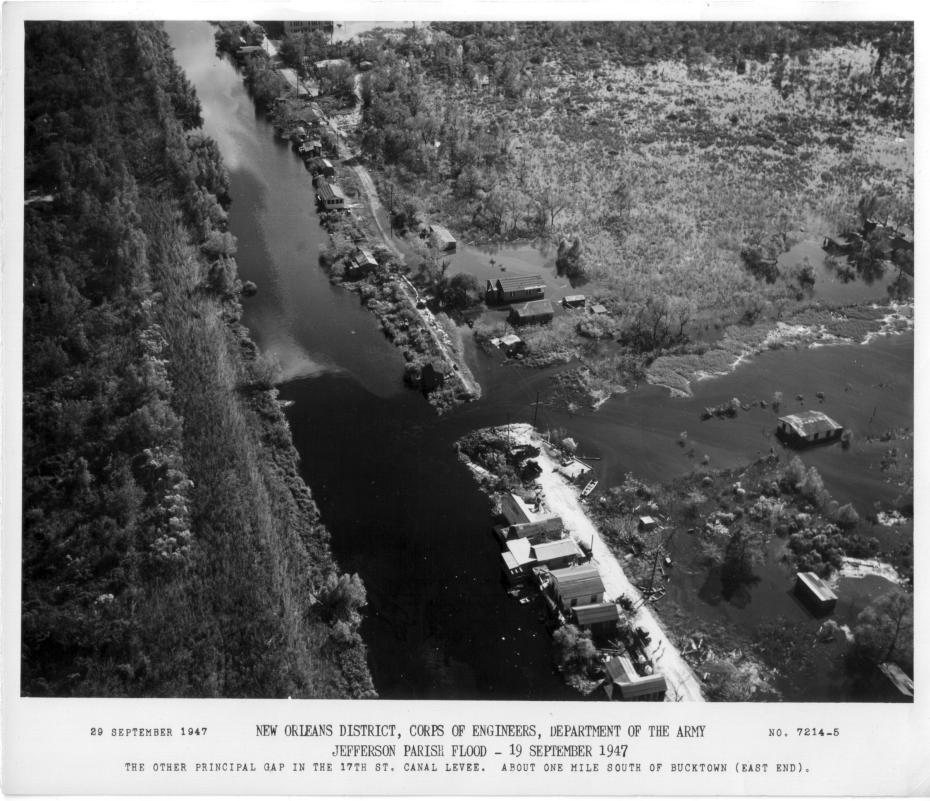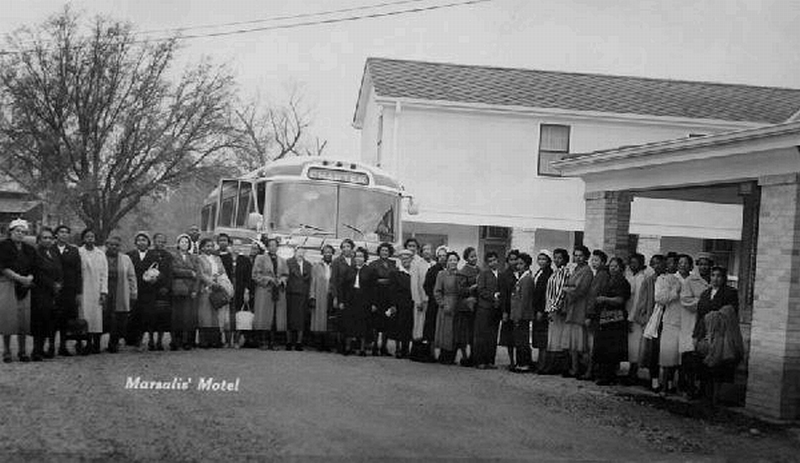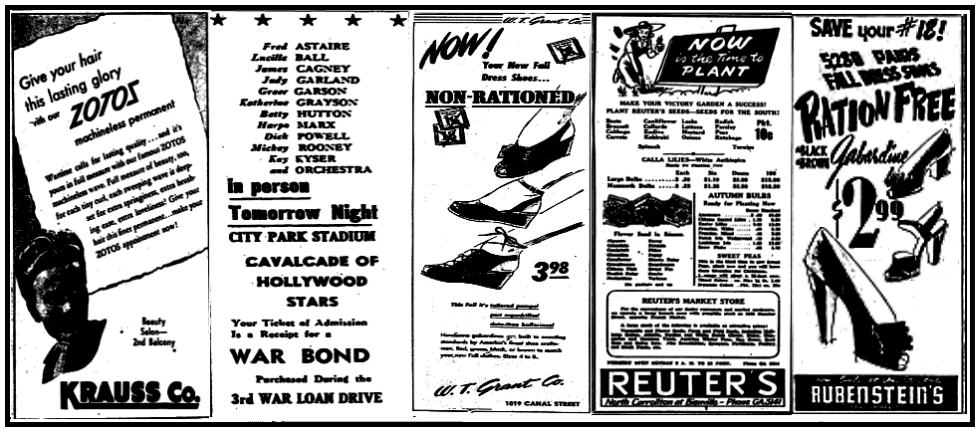|
Today in New Orleans History |
|
|
September 19


 To receive an update for each day in New Orleans history,
join our facebook page - Today in New
Orleans History.
A large part of Greater New Orleans was flooded, with 2 ft of water shutting down Moisant
Field and 6 ft of water in parts of Jefferson Parish. The storm surge in Louisiana peaked at 9.8–11.2 ft
(3.0–3.4 m) at Shell Beach on Lake Borgne and at 11.5 ft in Ostrica. The surge
over-topped the 9-ft-tall Orleans Parish seawall, built by the Orleans Levee Board in the 1920s to prevent a repeat
of the 1915 hurricane there, and spread water over 9 sq mi of the parish, as far from Lake Pontchartrain as Gentilly
Ridge. Parts of Jefferson Parish were flooded for as long as two weeks. Subsidence settled behind the levees,
leaving “topographic bowls” containing up to 6 ft of water, to be excavated by dredging and
pumping the water back into Lake Pontchartrain. Saint Bernard and Plaquemines parishes were also inundated
by an 11-ft storm surge, though mainly sparsely populated areas were affected.  To receive an update for each day in New Orleans
history, join our facebook page
- Today in New Orleans History
Earl Cyril Palmer born in New Orleans and raised in the Tremé
(October 25, 1924 – September 19, 2008) was an American rock & roll and rhythm
and blues drummer, and member of the Rock and Roll Hall of Fame. Palmer played on many recording sessions, including Little
Richard's first several albums and Tom Waits' 1978 album Blue Valentine. playing on New Orleans recording sessions, including
Fats Domino's "The Fat Man", "I'm Walkin" (and all the rest of Domino's hits), "Tipitina"
by Professor Longhair, "Tutti Frutti" by Little Richard (and most of Richard's hits), "Lawdy Miss Clawdy"
by Lloyd Price, and "I Hear You Knockin'" by Smiley Lewis.
Jazzman Andrew Morgan Dies Born on March 13, 1901 in Plaquemines Parish,Andrew Morgan played clarinet with the Imperial Band in the mid-1920s and then joined his brother Isaiah Morgan's band in 1925. Sam Morgan led this ensemble for its 1927 recordings. Andrew recorded in the late 1920s and 1930s with Kid Howard, Kid Rena, and Kid Thomas Valentine. He and Isaiah played together again in Biloxi, Mississippi in the 1940s, then Andrew moved back to New Orleans to play with Alphonse Picou, Kid Rena again, Herb Morand (1946–52), and Kid Clayton (from 1952). He played with the Young Tuxedo Brass Band from 1958 and led the group after 1964. Morgan played with Percy Humphrey in 1953, Sweet Emma Barrett in 1960, Kid Howard again in 1962, Alvin Alcorn in 1964, Onward Brass Band in 1965, Eureka Brass Band in 1969, and with Captain John Handy in 1970. He recorded as a leader in 1969 for the album Down By the Riverside. Ellis Louis Marsalis Sr. Dies In 1943 Ellis Louis Marsalis Sr. converted
a chicken barn at 110 Shrewsbury Road at the river (across the street from what is now The Rivershack) into the 40-room Marsalis'
Motel complete with a swimming pool, restaurant, and lounge. Also known as Marsalis Mansion, and Marsalis Tourist
Home, from 1943 to 1986 it was one of the only motels open to African Americans traveling to New Orleans. Reverend
Martin Luther King Jr., Congressman Adam Clayton Powell Jr., future Supreme Court Justice Thurgood
Marshall, Ray Charles, and other prominent civil rights activists, politicians, and musicians stayed there along
with thousands of lesser known Black travelers. Marsalis was,
himself, active in promoting equal rights in his community and served as president
of the Nationwide Hotel Association. In 1933, he
married Florence Robertson, whom he had met while enrolled in night school. They had two children, .Yvette Washington
and Ellis Jr. In 1936, Ellis Sr. and William Wicker's Esso gas station at Eighth Street and Howard Avenue was
the first African American-owned station in the area. While managing the
hotel he promoted positive change in the community by organizing the Boosters Club, which registered African American
voters throughout New Orleans. He was an active member of the local Republican
Party who was elected in 1967 (the year he also expanded the motel and added The Broaster House restaurant to it) to serve
on the Republican Executive Committee and served as its treasurer. He was a delegate to The Republican Presidential
Convention of 1964. .In 1969 he was a a member of the Advisory Committee of the Social Welfare Planning
Council. He assisted David Treen's
successful 1982 campaign for Louisiana Governor. . He helped finance the
education of Ernest Nathan Morial ("Dutch"), the first Black student to attend the Louisiana
State University Law School, and who became the first Black mayor of New Orleans. Marsalis also played a role in
the election of Judge Lionel Collins, the first Black Judge of the 24th Judicial District Court, in Gretna, Louisiana. His daughter Yvette Marsalis Washington helped him run the motel
after her mother's death in 1973. Ellis Jr. become an excellent jazz pianist and music professor who mentored gifted
young New Orleans musicians including Harry Connick Jr.. His grandsons trumpeter
Wynton, saxophonist Branford, trombonist Delfeayo, and drummer Jason are renowned musicians. The achievements earned by Ellis Marsalis and like-minded civil rights activists led
to the demise of the hotel -- which was no longer needed as a haven for black travellers. Marsalis's Mansion Motel
closed on September 25, 1986, demolished in July 1993, and its property sold in July 2006. It remains an empty
lot across the street from The Rivershack. Active in St. James A.M.E. Church, the Dryades Street Y.M.C.A., a 32nd-degree member of the Ancient and Accepted Scottish Rite of Freemasonry, and patriarch to
one of New Orleans' most celebrated musical families Mr. Marsalis passed away at the Ochsner Foundation Hospital on September 19, 2004 at the
age of 96. Jimmy Anselmo is Born New Orleans
born James Anselmo spent his lifetime in the music business. After serving on U.S.S. Saratoga Navy aircraft carrier and earning
an honorable discharge from the Navy in 1965, his first job back in New Orleans was as a bartender working the 3 a.m. graveyard
shift at Papa Joe’s on Bourbon Street and consequently became friends numerous with local musicians. Among that
number were Mac Rebennack before he became the famous Dr. John and an unknown Freddy Fender. In 1972 he created Quasimodo’s out of Al Pellegrini’s pool hall
on Willow Street. In late 1976 he bought the building from Pellegrin for $13,000. After wrangling through the
process of applying for a Small Business Administration loan and six months of renovations, Jimmy’s Music Club opened
on April 9, 1978. The first two shows starred Little Queenie and the Percolators and the Neville Brothers.
Stars Entertain to Support the War Effort September 19, 1943 On September 19, 1943 at 8 P.M. City Park Stadium glistened with stars above and onstage. Judy Garland,
Fred Astaire, Dick Powell, and 1943 Academay of Motion Picture Arts and Sciences award winner Greer Garson performed to the
tunes of Kay Kyer and his Orhestra. New Orleans was one of 15 American cities included in this third War Loan
Campaign to sell War Bonds. In addition to the stars' variety show ticket holders also enjoyed band music, military
maneuvers, and Civil Defense demonstrations. Under the auspices of the War Activities Committee headed by Chairman E.
V. Richards the event was open to any and all who wished to fill one of the stadium's 40,000 seats by buying a $25 dollar
bond. Special sections of the field were reserved for those who purchased $1000, $10,000, or $100,000 bonds. New
Orleans' quota was set at $30,000. Those contributing to the successful event included E. Kirby Newburger, campaign
Director; Moise Block, Chairman of Special Events, and local women Block Leaders of the Civil Defense who canvassed
homes -- Mrs Furman Pierce chaired the block leaders.
New Orleans Jazz Club's annual Jazz
Festival The New Orleans Jazz Club's annual Jazz Festival
on September 19, 1954 at the Municipal Auditorium included Bourbon Street performers pianist Walter "Fats" Pinchon,
Sharkey Bonano and his Band, and Papa Celestin and his band as well as the Middlewest Dixieland Band for the show which benefited
Crippled Children's Hospital. The first canned beer, a Keglined
brand Pabst, was on the shelves in New Orleans on September 19, 1935. It was produced by The
American Can Company at 3700
Orleans Avenur. The new can was touted as taking less space in the refrigerator and in stores and better able
to protect the beer from spoilage. |
|
|

To receive an update for each day in New Orleans history,
join our facebook page - Today in New
Orleans History.
Analytics |




